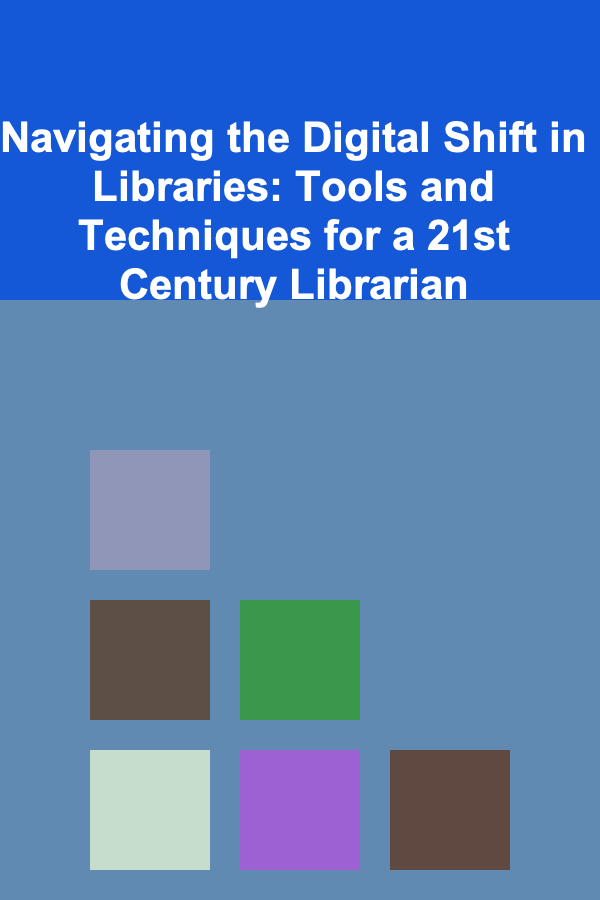
Navigating the Digital Shift in Libraries: Tools and Techniques for a 21st Century Librarian
ebook include PDF & Audio bundle (Micro Guide)
$12.99$6.99
Limited Time Offer! Order within the next:

The digital transformation of libraries is no longer a futuristic vision but a present reality. As technology rapidly advances, libraries must evolve to meet the changing needs of users, integrating digital tools and methodologies into traditional library services. Librarians today are not only curators of physical collections but also facilitators of information in an increasingly digital world. This actionable guide explores the tools, strategies, and techniques that 21st-century librarians can use to successfully navigate the digital shift and provide high-quality services in the digital age.
The Role of the Modern Librarian in the Digital Age
While libraries were once seen primarily as repositories of physical books, the digital age has transformed them into vibrant community hubs for information, learning, and collaboration. Librarians now serve as curators, educators, digital literacy experts, and technology integrators. Their role is no longer confined to managing books and journals; it includes facilitating access to digital resources, helping patrons navigate the internet, and supporting lifelong learning in an increasingly connected world.
The digital shift has brought about several significant changes:
- Increased Access to Information: Digital resources allow libraries to expand their collections beyond physical space limitations, offering access to e-books, journals, databases, and multimedia resources.
- Collaboration and Connectivity: Libraries can now connect with patrons and other libraries worldwide, making it easier for individuals to share knowledge, access educational resources, and collaborate on projects.
- Focus on Digital Literacy: Librarians are increasingly tasked with helping patrons develop the skills necessary to navigate digital spaces safely and efficiently. This includes understanding how to use digital tools, identify credible sources, and protect personal information online.
Digital Tools Every Librarian Should Master
As libraries embrace the digital shift, librarians need to become proficient in a range of digital tools to support both internal operations and user needs. Below are key categories of tools that every modern librarian should master:
1. Library Management Systems (LMS)
At the heart of library operations is the Library Management System (LMS), which allows librarians to catalog, track, and manage physical and digital collections. LMS platforms also support circulation, acquisitions, and interlibrary loans. Librarians need to ensure that they are using an LMS that fits the library's size, resources, and user needs.
Actionable Steps:
- Evaluate LMS Options: Research and select an LMS that aligns with the library's operational needs, whether it's open-source (e.g., Koha) or commercial (e.g., Ex Libris Alma).
- Training and Familiarization: Ensure that all staff members are trained to use the LMS efficiently. Regularly update the system to incorporate new features and improvements.
- Data Analysis: Use the data provided by the LMS to analyze usage trends, identify popular resources, and assess collection gaps.
2. Digital Archives and Repositories
Digitization efforts have made it possible for libraries to store and preserve documents, books, images, and other materials in digital formats. These digital archives and repositories are essential tools for curating and managing collections that are accessible remotely.
Actionable Steps:
- Digitize Special Collections: Prioritize digitizing rare and fragile materials to ensure their preservation while making them accessible to a broader audience.
- Use Open-Source Tools: Leverage open-source tools like OpenDPLA, Islandora, or CONTENTdm to create, manage, and share digital collections.
- Enable Remote Access: Ensure that digital archives are accessible to users globally by offering access through web portals and integrating them with library catalogs.
3. E-Book and Audiobook Platforms
The demand for e-books and audiobooks has skyrocketed in recent years. Libraries must now offer access to digital books, audiobooks, and e-magazines to meet the needs of digital-native patrons. Platforms like OverDrive, Hoopla, and Libby are popular choices for providing access to these materials.
Actionable Steps:
- Partner with Content Providers: Collaborate with platforms like OverDrive or Hoopla to expand your library's e-book and audiobook collection.
- Promote Digital Lending: Educate patrons about how to borrow and read e-books or listen to audiobooks using mobile devices and digital apps.
- Ensure Accessibility: Make sure that e-books are accessible to individuals with disabilities by offering formats like large print, audio, and braille versions.
4. Cloud Storage and Collaborative Tools
Libraries are increasingly using cloud-based services for storage, collaboration, and communication. Cloud tools offer flexibility, security, and easy access to shared resources, allowing staff to collaborate on projects remotely and patrons to access materials from anywhere.
Actionable Steps:
- Adopt Cloud Storage Services: Use cloud-based platforms like Google Drive, Dropbox, or Microsoft OneDrive for storing digital resources and collaborating on library projects.
- Implement Collaborative Platforms: Encourage staff to use tools like Slack, Microsoft Teams, or Trello to manage projects and communicate efficiently.
- Offer Cloud Access to Patrons: Provide patrons with cloud-based access to online resources and digital collections, ensuring easy, remote access to library materials.
5. Social Media and Community Engagement Tools
In today's interconnected world, social media platforms are crucial for engaging with library patrons and promoting library events, programs, and services. Librarians should be well-versed in using social media to communicate with users, share resources, and build community.
Actionable Steps:
- Utilize Social Media: Use platforms like Facebook, Twitter, Instagram, and LinkedIn to engage with the community, promote library services, and share updates.
- Create Online Communities: Foster digital spaces where patrons can connect, share ideas, and collaborate. This can include book clubs, forums, or discussion groups.
- Monitor Engagement: Use social media analytics tools to measure the success of your library's online presence and adjust your strategy accordingly.
Digital Literacy and User Support
One of the most critical aspects of the digital shift is ensuring that patrons have the skills they need to navigate the digital world safely and effectively. Digital literacy has become a core component of library services.
1. Offering Digital Literacy Programs
Librarians must take on the role of educators, helping patrons develop the skills necessary to thrive in a digital society. Digital literacy programs should be tailored to the needs of different user groups, from children and students to seniors and underserved populations.
Actionable Steps:
- Develop Tailored Programs: Create digital literacy workshops and classes that cover basic skills, such as using the internet, online safety, and social media etiquette.
- Offer One-on-One Support: Provide personalized assistance to patrons who need help with specific digital tools or platforms.
- Partner with Schools and Community Organizations: Collaborate with local schools, nonprofits, and businesses to offer joint programs that promote digital literacy in the community.
2. Supporting Information Literacy
Information literacy involves helping patrons find, evaluate, and use information effectively. In the digital age, this is particularly important, as the internet is filled with both reliable and unreliable sources.
Actionable Steps:
- Host Workshops on Information Evaluation: Teach patrons how to evaluate online resources for credibility, bias, and relevance.
- Create Online Guides: Develop online tutorials and resource guides to help users understand how to conduct research, cite sources, and avoid plagiarism.
- Promote Critical Thinking: Encourage patrons to ask questions and approach information critically, emphasizing the importance of source verification.
3. Offering Access to Assistive Technologies
Libraries should provide assistive technologies to ensure that individuals with disabilities have equal access to library resources. This can include screen readers, voice recognition software, and adaptive devices for users with physical or sensory impairments.
Actionable Steps:
- Equip Libraries with Assistive Technologies: Ensure that library computers and workstations are equipped with tools like JAWS (Job Access With Speech), ZoomText, or Dragon NaturallySpeaking.
- Train Library Staff: Provide staff with training on how to use and assist patrons with assistive technologies.
- Promote Accessibility Services: Publicize the availability of assistive technologies to ensure that all patrons are aware of the resources available to them.
Adapting Library Spaces for Digital Services
While digital tools are essential, physical library spaces must also adapt to meet the needs of digital users. The library environment should be conducive to both traditional and digital activities.
1. Creating Collaborative Spaces
Modern libraries are evolving from traditional reading rooms to spaces designed for collaboration and innovation. These spaces should include comfortable seating, flexible workstations, and access to digital tools that encourage teamwork and creativity.
Actionable Steps:
- Design Flexible Spaces: Create areas where users can work individually or collaborate in groups. Incorporate movable furniture, whiteboards, and large-screen displays.
- Integrate Technology: Provide access to tablets, laptops, and multimedia equipment for users to engage in digital projects and activities.
- Host Maker Spaces: Consider setting up maker spaces with equipment like 3D printers, scanners, and other digital creation tools for community use.
2. Emphasizing Mobile Access
In today's world, mobile devices are the primary means by which many people access digital content. Libraries must ensure that their digital resources are optimized for mobile devices.
Actionable Steps:
- Develop a Mobile-Friendly Website: Ensure that the library's website, catalogs, and digital resources are fully accessible on smartphones and tablets.
- Offer Mobile Apps: Provide apps that allow patrons to search the catalog, check out materials, and access digital content from their mobile devices.
- Promote Mobile Accessibility: Publicize the availability of mobile-friendly services and encourage users to engage with the library's resources on their devices.
Conclusion
Navigating the digital shift in libraries requires librarians to embrace new tools, technologies, and teaching strategies that empower patrons and transform library services. By mastering digital tools, promoting digital literacy, and creating inclusive and accessible environments, librarians can play a pivotal role in shaping the future of libraries. As technology continues to evolve, librarians must remain agile, innovative, and committed to fostering an information-rich society where all individuals have the tools they need to succeed in a digital world.

How to Organize Holiday Clothing for Easy Access
Read More
How to Scale Your Small Business by Integrating Process Automation
Read More
Securing Tomorrow's Technology: An Essential Guide for IT Managers
Read More
The Art of Execution: How to Stand Out by Delivering Results
Read More
How to Understand E-commerce for Small Businesses
Read More
How to Predict the Future of Blockchain Technology
Read MoreOther Products

How to Organize Holiday Clothing for Easy Access
Read More
How to Scale Your Small Business by Integrating Process Automation
Read More
Securing Tomorrow's Technology: An Essential Guide for IT Managers
Read More
The Art of Execution: How to Stand Out by Delivering Results
Read More
How to Understand E-commerce for Small Businesses
Read More